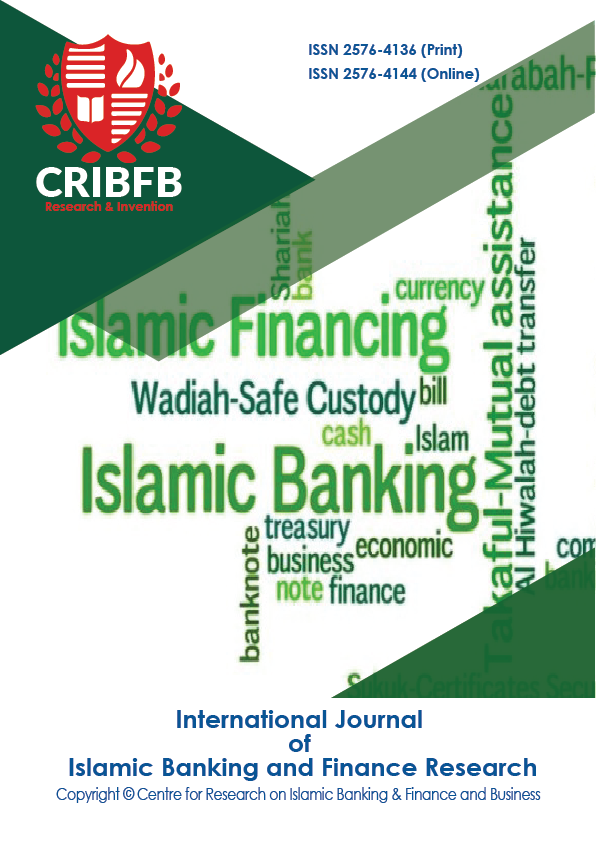THE IMPACTS OF BORROWERS ATTITUDE AND ACCESSIBILITY TO NON-INTEREST LOAN ON THEIR WELFARE DURING COVID-19 PANDEMIC: A CASE OF TRICYCLE RIDERS IN KWARA STATE, NIGERIA
Main Article Content
Abstract
This study examines the impacts of borrowers' attitudes and accessibility to non-interest loans on the welfare of tricycle riders in Kwara State, Nigeria, during the COVID-19 pandemic. The objective is to gain insights into how these factors influence the well-being of tricycle riders and provide recommendations for enhancing their welfare in challenging times. The study utilizes a quantitative research approach and collects data through a field survey. The demographic data of the respondents indicate that the sample predominantly consists of male respondents and individuals following the Islamic faith. The majority of respondents have completed the Senior Secondary Certificate Examination, followed by non-formal education and NCE/HND qualifications. Most respondents are married and fall within the age group of 36-45 years. Regression analysis is employed to analyze the data. The findings reveal that both accessibility to non-interest loans and borrowers' attitudes towards borrowing significantly impact the welfare outcomes of tricycle riders. Access to non-interest loans is positively associated with welfare, while negative attitudes towards borrowing are linked to lower welfare outcomes. Recommendations include enhancing access to non-interest loans, providing financial literacy programs, addressing negative attitudes towards borrowing, strengthening social safety nets, and fostering collaborative partnerships among stakeholders. This study contributes to the understanding of the welfare dynamics of tricycle riders in Kwara State, Nigeria, during the COVID-19 pandemic. It provides valuable insights for policymakers, financial institutions, and other relevant stakeholders to develop targeted interventions that support the welfare and economic resilience of tricycle riders and similar informal sector workers.
JEL Classification Codes: L26, E32, E02.
Downloads
Article Details
Section
How to Cite
References
Ali, M., & Hassan, M. K. (2019). Non-interest banking and financial inclusion in Pakistan: The mediating role of financial literacy. Borsa Istanbul Review, 19(2), 100-111.
Amendola, A., Boccia, M., Mele, G., & Sensini, L. (2016). Financial access and household welfare: evidence from Mauritania. Policy Research Working Paper-World Bank, (7533). Retrieved from https://www.mfw4a.org/sites/default/files/resources/Financial_Access_and_Household_Welfare_Evidence_from_Mauritania.pdf
Anifowose, O. L. (2016). Non-interest financing as a tool for poverty alleviation in Nigeria. Development Finance Agenda (DEFA), 2(3), 24-29. Retrieved from https://journals.co.za/doi/abs/10.10520/EJC199158
Blau, P. M. (1964). Exchange and power in social life. John Wiley & Sons.
Emerson, R. W. (2015). Convenience sampling, random sampling, and snowball sampling: How does sampling affect the validity of research? Journal of Visual Impairment & Blindness, 109(2), 164-168. https://doi.org/10.1177/0145482X1510900215
Ferrari, A., Masetti, O., & Ren, J. (2018). Interest rate caps: the theory and the practice. World Bank Policy Research Working Paper, (8398). https://doi.org/10.1596/1813-9450-8398
Homans, G. C. (1958). Social behavior as exchange. American Journal of Sociology, 63(6), 597-606. Retrieved from https://www.jstor.org/stable/2772990
Ismail, N. A., Adeniji, T. A., & Paul, O. J. (2018). Assessment of tricycles operations as an alternative means of urban transport in Lokoja, Kogi State. Confluence Journal of Environmental Studies, 12(1), 53-62.
Johnson, R. T., & Patel, S. A. (2020). Access to finance and welfare improvement among micro entrepreneurs in India: The role of caste, education, and borrowing attitudes. Journal of International Development, 32(1), 65-91.
Joshi, A., Kale, S., Chandel, S., & Pal, D. K. (2015). Likert scale: Explored and explained. British Journal of Applied Science & Technology, 7(4), 396-403. https://doi.org/10.9734/BJAST/2015/14975
Manrique, J., & Ojah, K. (2004). Credits and non-interest rate determinants of loan demand: a Spanish case study. Applied Economics, 36(8), 781-791. https://doi.org/10.1080/0003684042000229514
Nguyen, T. D., & Du, Q. L. T. (2022). The effect of financial inclusion on bank stability: Evidence from ASEAN. Cogent Economics & Finance, 10(1), 1-14. https://doi.org/10.1080/23322039.2022.2040126
Salia, P. J. (2014). The effect of microcredit on the household welfare (empirical evidences from women micro-entrepreneurs in Tanzania). International Journal of Academic Research in Business and Social Sciences, 4(5), 259-272. http://dx.doi.org/10.6007/IJARBSS/v4-i5/853
Smith, P. M., Brooks, R. P., & Black, R. J. (2018). Borrowing to grow: The relationship between lending attitudes and entrepreneurship. Journal of Small Business Management, 56(S1), 26-47.




